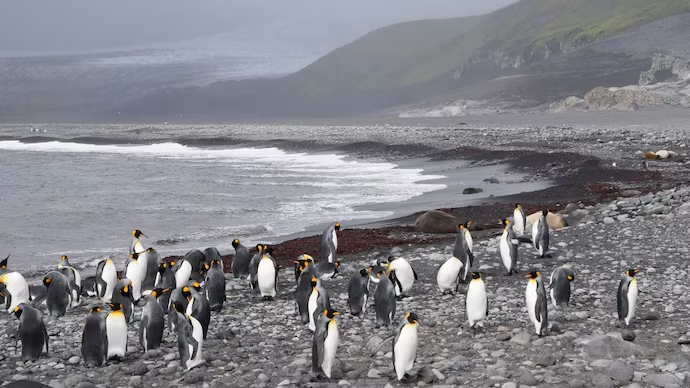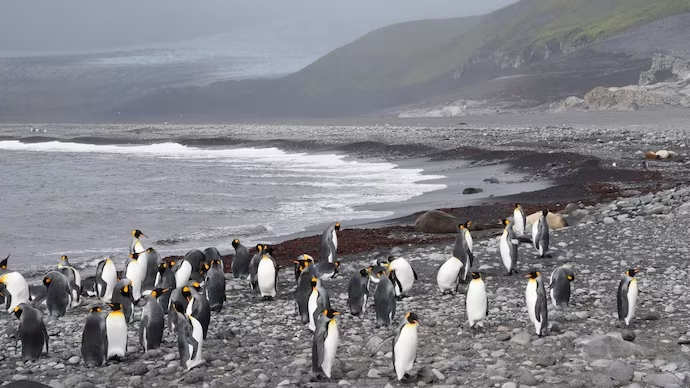Trump’s 10% tariff on Heard and McDonald Islands, home only to penguins, sparks outrage. Explore the details at America News World (ANW).

On April 2, 2025, President Donald Trump dropped a bombshell. He announced new tariffs targeting over 180 countries and territories. Among them? The remote Heard Island and McDonald Islands. These volcanic specks near Antarctica have no people. Just penguins, seals, and glaciers. Yet, they now face a 10% tariff on goods. The news stunned many. How can islands with no exports get hit? Let’s dive into this wild story and unpack what’s happening.
Transitioning to the basics, these islands belong to Australia. They sit in the Southern Ocean, about 4,100 kilometers southwest of Perth. Reaching them takes a grueling two-week boat trip. No one lives there. The last human visit was nearly a decade ago. So, why target them? Trump says it’s about fairness. He calls these “reciprocal tariffs.” Countries that tax U.S. goods, he argues, should face the same. But here’s the catch: these islands don’t trade. They’re a pristine wilderness, not a bustling market.
Why This Move Feels Absurd
Imagine taxing a ghost town. That’s what this feels like. The Heard and McDonald Islands are a UNESCO World Heritage Site. They’re untouched by humans. No factories, no shops, no shipping ports. Just wildlife thriving in peace. Penguins waddle along icy shores. Seals bask on rocky beaches. Birds soar above active volcanoes. Yet, Trump’s tariff chart lists them alongside big players like China and India. It’s baffling. Australia’s Prime Minister, Anthony Albanese, didn’t hold back. “Nowhere on earth is safe,” he said, voice dripping with frustration.
Transitioning to his reaction, Albanese called it illogical. “This is not the act of a friend,” he added. He pointed out the strong ties between the U.S. and Australia. Partners don’t slap tariffs on empty lands. Still, he vowed not to retaliate. “We won’t join a race to the bottom,” he said firmly. Higher prices and slower growth? No thanks, he argued. Australia will keep selling to the U.S. without a fight.
Trump’s Big Tariff Plan
Now, let’s zoom out. Trump’s announcement wasn’t just about these islands. It’s part of a massive trade shake-up. He spoke from the White House Rose Garden on April 2, 2025. His goal? Make America “wealthy again.” He promised jobs would come “roaring back.” The plan hits 180 countries with tariffs ranging from 10% to 54%. China got the worst of it at 54%. India faces 27%. The European Union? 20%. Even tiny places like the Cocos Islands got tagged at 10%. Trump held up a chart. It showed what others charge the U.S. His response? Match it—or close to it.
For example, he singled out India. “They charge us 52%,” he said, shaking his head. “Very, very tough.” He mentioned a recent chat with India’s Prime Minister. “You’re a great friend,” Trump told him. “But you’re not treating us right.” So, the U.S. now levies 27% on Indian goods. It’s a discount, he said, but still a bold move. Transitioning to his logic, Trump believes this levels the playing field. For years, he claims, America got ripped off. Now, he’s fighting back.
The Heard and McDonald Puzzle
But back to those islands. Why include them? A White House official told Axios it’s simple. They’re Australian territory. If Australia gets a 10% tariff, so do its lands. Fair enough, right? Not really. The Heard and McDonald Islands don’t export anything. No fish, no tech, no trinkets. The U.S. imported $1.4 million in goods from there in 2022, says the World Bank. Mostly “machinery and electrical” stuff. How? No one’s sure. Experts call it a data glitch. Before that, imports ranged from $15,000 to $325,000 yearly. Tiny numbers. Probably errors.
Transitioning to the reality, these islands are a nature haven. Heard Island has an active volcano called Big Ben. McDonald Island is smaller, surrounded by rocky outcrops. Glaciers cover much of the land. Penguins—king penguins, to be exact—rule the beaches. Elephant seals lounge in droves. Scientists visit sometimes. They study climate change and wildlife. But trade? Zero. So, a 10% tariff feels like a punchline to a bad joke.
The World Reacts with Shock
People didn’t stay quiet. Social media lit up. “Trump tariffs penguins!” one X user quipped. Another wrote, “The penguins have been ripping us off for years!” Sarcasm flowed freely. Critics mocked the absurdity. “Taking on America’s real enemies—a bunch of islands you’ve never heard of,” said Brendan Duke from the Center on Budget and Policy Priorities. Even Trump’s ex-aide, Anthony Scaramucci, chimed in. “Those penguins need to pay,” he tweeted, dripping with irony.
Transitioning to serious voices, experts raised red flags. Elizabeth Buchanan, a polar geopolitics guru, called it questionable. “This breaches the Antarctic spirit,” she told WIRED. The Antarctic Treaty pushes peace and science, not trade wars. Australia claims these islands, sure. But they’re managed by the Australian Antarctic Division. Their job? Protect nature, not ship goods. So, what’s the tariff for? No one at the White House explained.
Numbers Tell a Strange Story
Let’s look at some data. Here’s a breakdown of Trump’s tariffs on a few places:
| Place | Tariff Rate | Population | U.S. Imports (2022) |
|---|---|---|---|
| Heard & McDonald Islands | 10% | 0 | $1.4 million |
| mainland Australia | 10% | 26 million | $16.8 billion |
| Norfolk Island (Australia) | 29% | 2,188 | Minimal |
| China | 54% | 1.4 billion | $536 billion |
| India | 27% | 1.4 billion | $83 billion |
[Image Graph: Tariff Rates Across Regions]
This table screams oddity. China and India? Big trade players. Makes sense. But Heard and McDonald? Zero population, tiny imports—if any. Norfolk Island, another Australian spot, got hit with 29%. It’s got 2,000 people. Barely a blip. Why the higher rate? No answer yet. The White House stayed mum when asked.
Economic Fallout Looms
Transitioning to the bigger picture, these tariffs stir fear. Markets dipped after Trump’s speech. The S&P 500 and Nasdaq saw their worst losses since 2022. Goldman Sachs upped its recession odds. “The risk is greater than people think,” they warned. Higher prices could hit American families hard. Businesses might cut back. Exports could tank. It’s a gamble. Trump sees it as a golden ticket. Critics? They see chaos.
For the islands, though, nothing changes. Penguins don’t pay taxes. Seals don’t ship goods. But the move signals something deeper. Trump’s ready to tax anything, anywhere. “Nowhere on earth is safe,” Albanese’s words echo. He’s not wrong. Even the wildest corners feel the heat.
What’s Next for America and Beyond?
So, where do we go from here? Trump’s tariffs kicked in at midnight, April 2, 2025. That’s 3 PM AEDT for Australia. For Heard Island? 9 AM local time. Not that it matters. No one’s there to notice. Australia won’t fight back, says Albanese. But others might. China’s already grumbling. The EU’s prepping a response. India could push back too. A global trade war? It’s possible.
Transitioning to my take, I’m stunned. I run AMERICA NEWS WORLD (ANW), and this is one for the books. Taxing empty islands feels like a fever dream. Yet, it’s real. Trump’s doubling down on his “America First” vibe. Will it work? Hard to say. Jobs might return. Or prices might soar. Either way, the world’s watching.
A Deeper Look at the Islands
Let’s explore these islands more. Heard Island spans 37,000 hectares. That’s a bit bigger than Philadelphia. It’s rugged—rocks, ice, and lava. McDonald Island is tinier, with smaller rocky neighbors. No trees, no grass. Just raw nature. The Australian Antarctic Division runs the show. They guard it fiercely. Ships visit rarely—mostly for science or fishing checks. Tourism? Forget it. You need a permit, and it’s a nightmare to get.
Transitioning to their value, these islands are gold for science. They’re a baseline for a healthy ecosystem. No alien plants or animals. No human mess. Researchers track glaciers shrinking. They study penguin colonies. It’s a living lab. Slapping tariffs on it? It’s like taxing a museum.
Wrapping Up the Madness
In the end, this tariff saga is wild. Trump’s move on Heard and McDonald Islands is a head-scratcher. It’s bold, sure. Powerful, maybe. But logical? Not really. It’s emotional—stirring anger, confusion, and laughs. At AMERICA NEWS WORLD (ANW), we’ll keep digging. Check out India Today for more global takes on this. For now, the penguins march on, unbothered. The world? Not so much.
